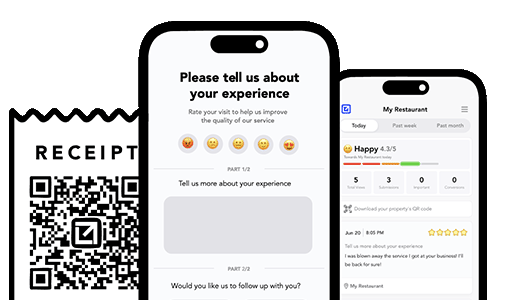Smart Ways to Get More Reviews [Guide]
Practical, proven ways for any business to get more authentic reviews.

TLDR: Yelp reviews are one of the most powerful drivers of foot traffic for local businesses, especially because Apple Maps pulls directly from Yelp, not Google. Unfortunately, Yelp’s policies also make it tricky to increase your rating without risking filtered reviews or policy violations. In this guide, we’ll walk you through how to ethically and effectively improve your Yelp rating. We’ll cover why Yelp matters so much (especially for iPhone users), what triggers Yelp’s spam filter, and how to increase legitimate, lasting reviews without manipulation. You’ll also learn how to turn casual visitors into Yelp advocates through subtle, feedback-first methods like signage, receipts, and in-the-moment prompts. Finally, we’ll explain how to handle negative reviews to protect your reputation, and how tools like VisibleFeedback help you catch problems early and nudge happy customers to share their experiences where it counts. Whether you’re trying to recover from a few bad reviews or build Yelp visibility from scratch, this guide gives you the honest blueprint to get there, no shady tactics, no violations.
Many businesses pour their energy into Google reviews, and that makes sense. Google dominates desktop search. But for mobile users, especially the 100+ million Americans on iPhones, the real kingmaker is Yelp. That’s because Apple Maps (which comes preinstalled on every iPhone) uses Yelp ratings, not Google’s.
When someone searches for “best sushi near me” or “top-rated hair salon” using Siri or Apple Maps, your Yelp score is what determines if you show up, and how trustworthy you look when you do. If you have few Yelp reviews or a lower score than competitors, you may be skipped without ever getting a chance.
Yelp is also heavily used by tourists, high-income demographics, and anyone relying on Apple devices. A great Google presence means little if iPhone users don’t see the same glowing picture.
Yelp is infamous for filtering out reviews. In fact, it’s not uncommon for a business to receive ten 5-star reviews, only to see half of them vanish into the “Not Recommended” section.
Here’s why:
Unfortunately, many honest businesses try to improve their Yelp standing the wrong way. They ask directly, offer discounts, or buy reviews, and then wonder why their rating doesn’t budge or even drops.
To improve your Yelp rating without getting flagged, you need to understand how Yelp’s algorithm works: it looks for natural, uncoached, unsolicited reviews. That means your job is to create the kind of experience people want to talk about, then give them a frictionless path to do it on their own.
So what actually works?
The key is subtlety, timing, and feedback-first thinking. Here’s a proven system that avoids flags and boosts real, lasting reviews:
Place QR codes around your store, checkout counter, or post-purchase emails. These should say things like:
This gives unhappy visitors a private outlet, and lets you nudge happy ones to Yelp after they’ve expressed satisfaction.
Instead of saying “Review us on Yelp!” try:
You’re not directly asking, which keeps you compliant, but you’re making the option visible.
The best time to get a review is right after a great experience, not later when the emotion has faded. Train staff to notice delighted customers and casually mention where they can share their thoughts.
No matter how great your business is, bad reviews happen. But they’re not a death sentence, if you handle them well.
Responding is crucial. Start with empathy, not excuses. Thank the customer for sharing, acknowledge their frustration, and offer a way to fix it (if appropriate). Future customers often read your responses even more than the review itself, they want to know how you handle problems.
Even unfair reviews can be turned into trust-builders. If your reply is calm, clear, and helpful, it shows you care about your reputation, and your customers.
You can also use negative reviews to improve. Are there recurring complaints? Is something confusing or inconsistent? Treat negative feedback as free consulting.
Improving your Yelp rating starts with knowing what your customers are thinking before they post online. That’s where tools like VisibleFeedback come in.
With real-time, in-store feedback collection, you can catch small issues before they become big problems. If someone had a confusing, uncomfortable, or frustrating moment, you’ll know about it, and can fix it quickly.
Even better: VisibleFeedback identifies your happy customers and makes it easy for them to leave public reviews, naturally. No pressure. No policy violations. Just organic review growth that boosts your reputation, on Yelp, Google, or anywhere else.
If your Yelp score isn’t where it should be, don’t panic. Don’t cheat. Build it the right way, and watch your visibility grow.

Bad reviews can scare away potential customers. Intercept feedback in real time with VisibleFeedback.

Austin Spaeth is the founder of VisibleFeedback, a simple tool that helps brick-and-mortar businesses intercept negative reviews before they go public. With a background in software development and a passion for improving customer experience, Austin built VisibleFeedback to give business owners a frictionless way to collect private feedback and turn unhappy visitors into loyal advocates. When he’s not working on new features or writing about reputation strategy, he’s probably wrangling one of his six kids or sneaking in a beach day.
Whether you have no reviews, bad ones, or great ones, we’ll help you turn your feedback into growth.
No credit card required.
⛨ Trusted by over 137 local businesses like yours